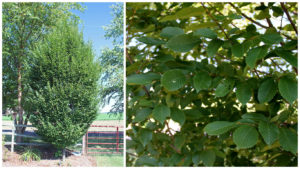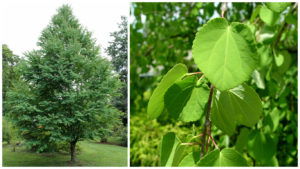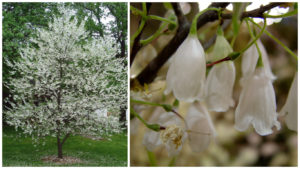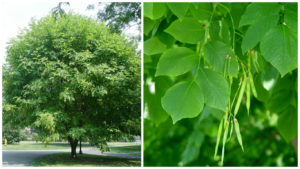12 Mid-Size Trees to Replace Those Dying Ashes
Now that ash trees are being decimated by the emerald ash borer, what are some good, mid-sized tree options?
Whether you’re looking to replace a dead ash or picking a new tree that the ash borer won’t kill, here are a dozen trees that grow in the 25- to 50-foot range.
1.) Hornbeam (Carpinus caroliniana)
Lean toward the native American hornbeam, a durable 25-footer with orange-red fall foliage and a smooth, gray trunk. Nicknamed “musclewood” for how the trunk looks like it’s flexing a thigh muscle.
Hornbeam is slow-growing, a favorite nesting tree of hummingbirds, and its fall winged nutlets feed wildlife. ‘Fastigiata’ is a narrow form for tighter areas.
2.) Black gum ‘Wildfire’ (Nyssa sylvatica)
Stunning bright-scarlet fall foliage is the main attraction that earned this native tree a 2013 Gold Medal Plant Award from the Pennsylvania Horticultural Society, but its new leaves also come out red.
Grows fairly fast to 50 feet but only about half that in width. Gets small white flowers in spring and blue fall fruits that birds relish. Prefers moist soil.
3.) Red maple (Acer rubrum)
Red maple is another fast-growing native tree most noted for its brilliant fall foliage – running scarlet-red to blood-red to orange-red depending on the variety.
Red Sunset and October Glory are two of the best, but Redpointe is a newer introduction with a more upright habit, excellent heat-tolerance, and resistance to the leaf yellowing (chlorosis) that plagues many maples.
Most grow 40 to 45 feet tall and 30 to 35 feet wide.
4.) Freeman maple Autumn Blaze (Acer x freemanii ‘Jeffersred’)
This strong-limbed, wind-tough hybrid has the stately form and structure as well as the orange-red fall foliage of its red-maple parent plus the durability of its silver-maple parent.
If you don’t like the “helicopters” of maple seed pods, this one hardly ever produces those. Grows about 50 feet tall and 40 feet wide.
5.) Paperbark maple (Acer griseum)
Paperbark maple is a non-native, slower-growing and slightly smaller maple best known for its red fall foliage and especially its peeling cinnamon-colored bark.
Grows about 25 feet tall and 20 feet wide.
6.) Katsura (Cercidiphyllum japonicum)
Here’s a little known, little used, trouble-free shade tree with a broad canopy and heart-shaped leaves that start out burgundy/purplish-green in spring, then turn green in summer, then turn a burnt-orange to yellow in fall.
Grows at a moderate rate to 40 to 50 feet tall and 25 to 30 feet. Also check out the weeping version of this tree if you’re looking for a front-yard specimen.
7.) Little-leaf linden (Tilia cordata)
This European-native shade tree has heart-shaped green leaves and fragrant, creamy spring flowers that are highly attractive to bees and butterflies. Also gets wildlife-attractive small winged nutlets in late summer.
The habit is pyramidal, and fall color is a non-showy pale yellow-green. Grows medium-fast to 50 feet tall and 35 feet across.
8.) Elm (Ulmus varieties)
Back from the brink of extinction threatened by the dreaded Dutch elm disease, breeders have been back-crossing survivors for decades and now have some very good, nearly 100-percent American elms that are unlikely to get the disease.
Try these stately, vase-shaped disease-resistant elms: Princeton, Valley Forge, New Harmony and Jefferson.
They grow moderately fast to 40 to 45 tall and 30 to 35 feet wide.
9.) Silverbell (Halesia carolina)
Native to the southeastern United States, silverbell offers a 30-foot canopy (perfect for small to mid-sized yards) as well as hanging, white, bell-shaped flowers in spring.
Leaves turn yellow in fall. Tree gets four-winged pods in fall, so it’s not a good choice next to a patio, though.
Prefers acid soil and a bit of afternoon shade.
10.) White oak (Quercus alba)
White oaks are native shade trees that can ultimately grow 60 feet tall and wide (and beyond), so you’ll need at least that amount of yard space.
But if you have the space, this is one of the strongest and most majestic of American hardwoods.
Leaves turn russet-red in fall. Bark is flaky and light gray in color. It’s also a heavy acorn producer if you like the idea of feeding wildlife.
11.) Yellowwood (Cladrastis kentukea)
Another southeastern U.S. native tree that’s under-used is yellowwood, which was good enough and tough enough to earn a 2015 Urban Tree of the Year award from the Society of Municipal Arborists.
The tree produces hanging strands of white flowers in May, then long pods that change from green to brown by fall. Fall foliage is yellow.
Grows 30 to 40 feet tall and slightly wider.
12.) Ginkgo (Ginkgo biloba)
This species that dates to dinosaur times is best recognized by its fan-shaped leaves that are a must in any elementary-school leaf-collecting project. (Do kids still do that?)
But the real highlight is in fall when those little fans turn a glowing gold. ‘Autumn Gold’ is particularly showy and grows about 45 feet tall and 30 feet wide. If you need something narrower, look to ‘Princeton Sentry.’
Avoid female types (rarely sold anyway) that produce very stinky fruits. Males don’t fruit. All ginkgos are very durable in urban conditions.













